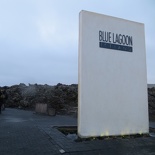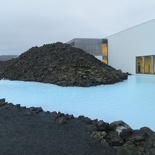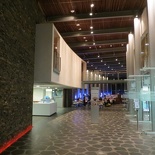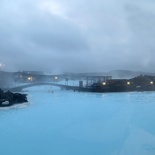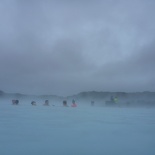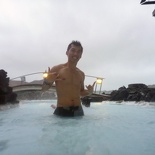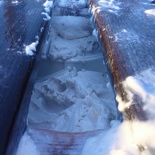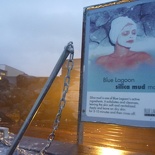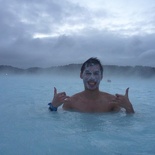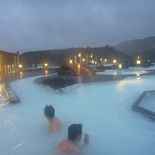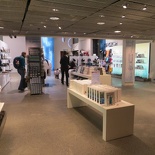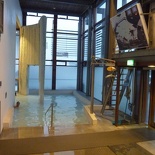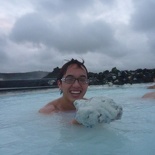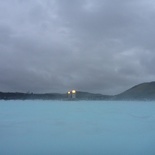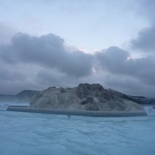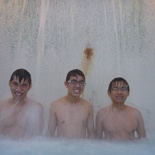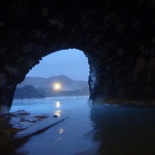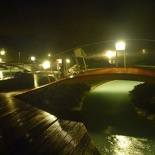The Blue Lagoon in Iceland is a geothermal spa is one of the most visited attractions in Iceland. Lonely planet ranks it as one of the top 5 most beautiful places in the world. The spa is located in a lava field in Grindavík on the Reykjanes Peninsula, southwestern Iceland and is about an hour drive from the capital city of Reykjavík. You may recognize it as one of the checkpoints in The Amazing Race 6 and the filming of the movie Hostel II.
There is a reason for the popularity of the lagoon, it being an easily recognizable place of indulgence and relaxation. The facility also offers several additional expensive indulges to pamper yourself such as spa treatments, massage and even VIP exclusive lounge access. These extras of course come at an extra on top of your already expensive entrance fee of 30 Euros per person, which is rather steep for a geothermal pool in my opinion.
The smallest and cheapest 200 ml soft drink at the lagoon bar for instance will set you back about $8 USD and bath towels and changing robes are a chargeable extra too. The Lagoon is a nice place if getting pampered is what you are after, without any worries of your bank account balance being hammered on. The various spa treatments and massages claim to blend nature and science together, providing guests with the energy of the geothermal seawater and its active ingredients: minerals, silica and algae.
Fueled by the Clean and mean
The lagoon is pretty energy self-sufficient too and is powered by the nearby Svartsengi Geothermal power plant which feeds it not only with power, but with piped superheated water vented from the ground near a lava flow, which is used to heat the trademarked warm steamy water lagoon pools, synonymous to that of hot springs and lava formations. The water is also used to run turbines that generate electricity for the facility.
Panorama of the Blue Lagoon
The water temperature in the bathing and swimming area of the lagoon averages 38 °C even in winter, often giving the lagoon its trademarked steamy and misty “postcard” look when viewed from afar. The lagoon water and silica mud are rich with different unique microalgae species derived from these hot geothermal water sources that makes them beneficial for the skin and are available thought-out the year, the lagoon is able to operate even in the coldest of the Icelandic winters.
Get butt naked before entering
If you hadn’t been to a Japanese Osen before, you may find the notorious policy in which all guests have to shower naked at the locker showers before dipping into the lagoon quite a bit well, unsettling to some people. This laughably leaves guests physically unconfident about themselves something to whimper about.
This is because all the pools used in the facility are non-chlorinated to maintain the proper mineral balance in the water. As such, hygiene is key. The warm waters are rich in minerals like silica and sulfur and excellent for the skin.
If you hadn’t been to a Japanese Osen before, you may find the notorious policy in which all guests have to shower naked at the locker showers before dipping into the lagoon quite a bit well, unsettling to some people.
The lagoon is themed to look as natural as possible with rock surfaces for walls and the lagoon floor, covered with finely ground dark volcanic soil for most part of the lagoon. It is one of the few places in Iceland which you definitely have to visit to make your stay worth and the experience, particularly as you will be missing something special if you don’t. However, I personally found it too commercialized and expensive; the place is after all a tourist trap.
But don’t get me wrong, the lagoon itself is very visually pretty, not to mention relaxing to have a soak in for a few hours in the warm dreamy surroundings. The area does not feel cold despite to sub-zero winter air all around you.
Silica beauty
Throughout the whole lagoon area, there are several Silica Mud Mask points which you can dig out of the soft clay buckets to self-administer mud masks on your face for your personal dermatological treatment. These mud dispensing points are littered around the northern areas of the lagoon, providing a first-hand taster to the Blue Lagoon silica mud facial treatment. The blue lagoon claims that the regular application of this mud on your skin defies the natural skin aging process.
The Blue Lagoon Iceland Silica Mud Mask is almost pure white, but often mostly spotting a light shade of gray, which seemed surprising for a silica mud mask technically made mainly out of silt. The silica content in the water gives the lagoon its iconic blue hue.
This miracle volcanic product is touted as the Iceland’s premiere beauty product, this Silica Mud Mask and sold as their house-branded silica mud, which you can buy in tube or tub forms from the attraction gift store on your exit. You can try on as much of the silica mud product in the lagoon as much as you want during your visit as a lagoon guest.
For Science!
The Blue Lagoon also operates an in-house Research and Development facility, with aims to find out more about the benefits of the algae and silica mud extracts. The key ingredient in most of the blue lagoon’s dermatological products is silica, which is sold in tubes, tubs or even infused into creams. It helps in the skin’s natural ability for collagen formation.
The center also aims to find cures for other skin ailments using the mineral-rich water as well as formulating them as consumable products which can be commercialized and reputed to for sale as beauty therapy products or as medical products for people suffering from skin diseases such as psoriasis. The Blue lagoon also claims that the silica mud is capable of inducing gene expression in human epidermal keratinocytes, helping with the reduction of trans-epidermal water loss.
The center also aims to find cures for other skin ailments using the mineral-rich water as well as formulating them as consumable products which can be commercialized and reputed to for sale as beauty therapy products or as medical products for people suffering from skin diseases such as psoriasis.
I personally find the claims quite a bit of a gimmick for a single trip unless you actually invest on their products on the long term basis, which does not come cheap either. I find their range of products too clinical and at times the attraction too crowded- not one which you might see yourself revisiting.
Moreover, the lagoon itself feels pretty artificial and not very clean in my opinion. Dredging the lagoon floor at the silica mud area often yields a handful of soft silica mud as well as a large handful of long human hairs in any scoop you pick up at any point around the lagoon, which questions how clean the water here really is with so much human sediments on the lagoon bed, despite the lagoon’s claims of the water being renewed every 2 days. Of course, ignorance can be bliss, as the water is often murky enough in silica to cut water visibility.
The lagoon also has a few additional facilities such as enclosed tunnels providing shelter from the chilly outdoors and an outdoor massage waterfall. You can hop between various sections of the Blue Lagoon such as a steam sauna through a number of walkway bridges littered between various pool sections. You can alternatively wade between the pools as they are all interconnected to one another, reducing the need to walk out in the cold. You are typically OK to walk around for a full minute before starting to feel chilly out of the water. A typical visit to the blue lagoon is good for 2-3 hours max. Well less than half a day in a trip from Reykjavík.
There are of course many other cheaper alternatives to the blue lagoon and with Iceland being a huge geothermal spot, you can often find many other simple and much cheaper alternatives to get your fix of soaking in a hot geothermal water even in the peak of winter. I would particularly recommend the Laugardalslaug Geothermal Pool right in the middle of Reykjavik city, it is a public swimming pool with various hot tubs with temperatures ranging from 38 to 44 degrees, with sea-water springs as well as steam baths and heated outdoor swimming pools, slides and a 50 meter competition pool, all for an entrance fee of 500 ISK (about $3 USD).
Overall, I had a rather good experience at the lagoon, the staff was very professional and helpful and does a good job in pampering you, at a price. The lagoon gets my recommendations for a visit to Iceland for its unique experience. Though I do question on its revisit value as there are many other cheaper alternatives and the lagoon is not the only geothermal hot spring in Iceland.
View more photos of the Blue lagoon here.

